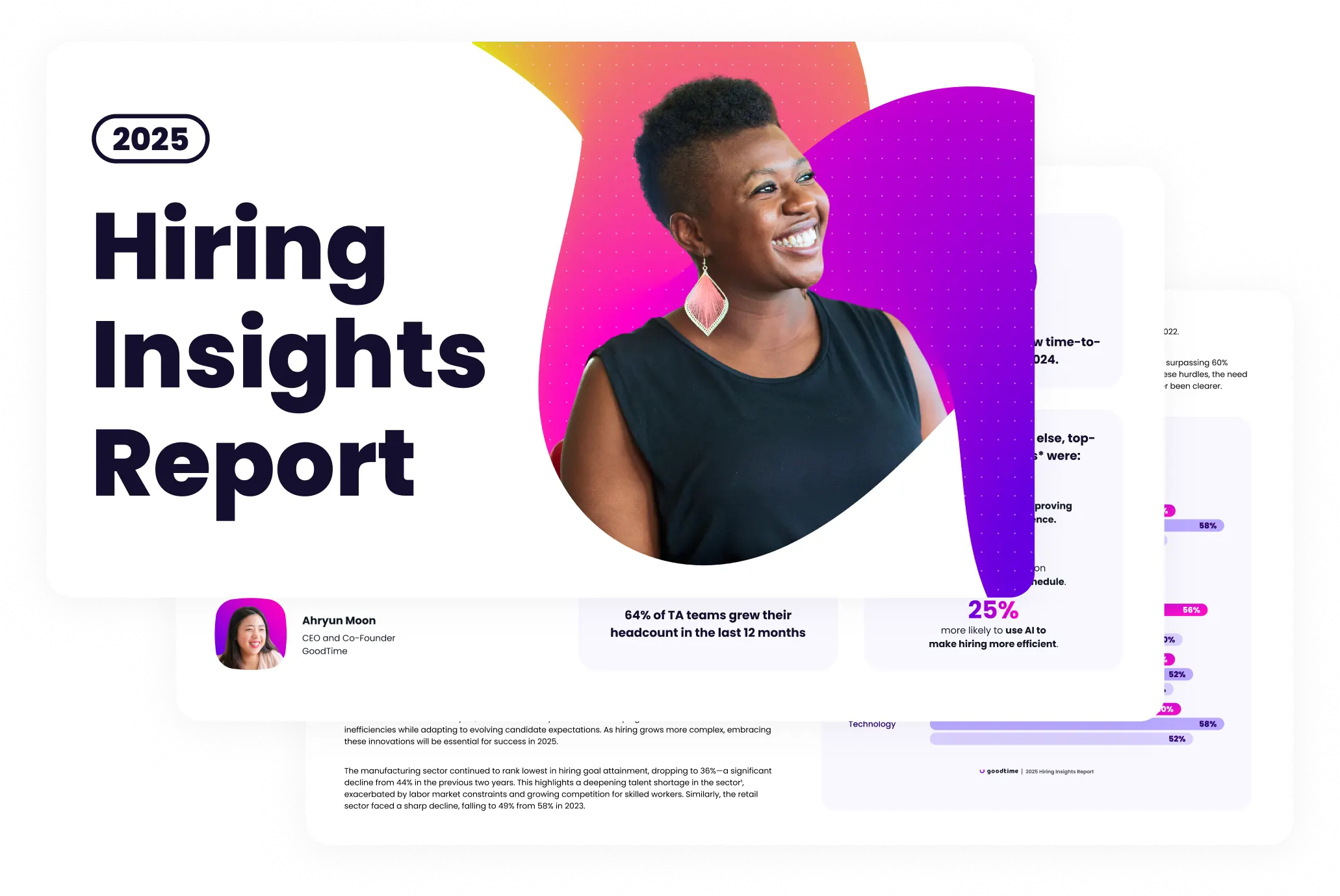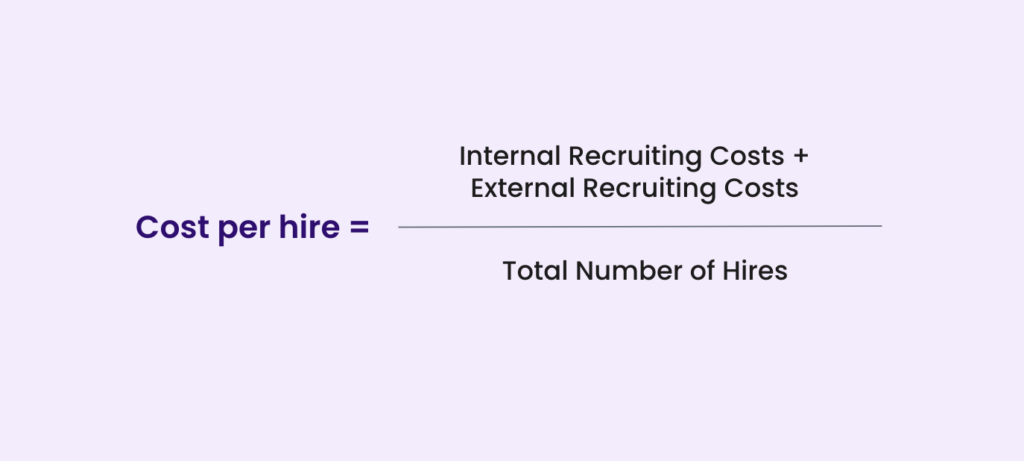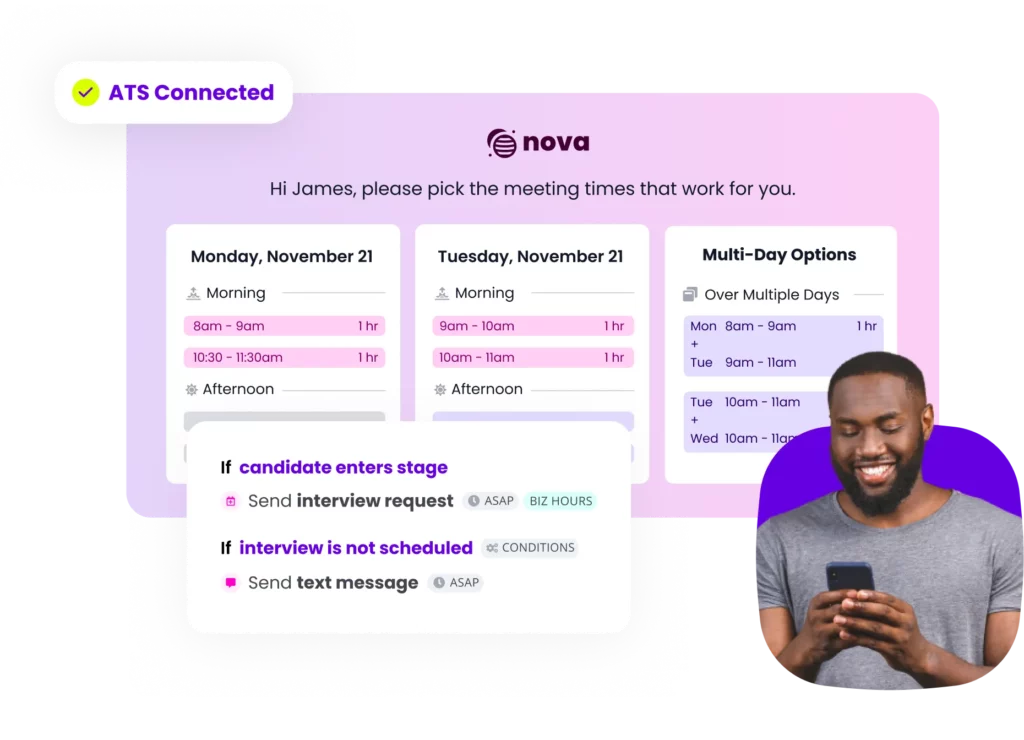The real cost of recruiting new talent is often overlooked, yet it silently shapes a company’s bottom line. Every step in the hiring process has a price tag that can add up pretty quickly behind the scenes.
The average cost of obtaining a new worker in the United States ranges from nearly $4,700 for a typical role to over $28,000 for an executive position—and if you employ the wrong person, the costs can double as you will have to repeat the recruitment process. Wouldn’t it be great if you could lower these figures as much as possible and invest the saved money in other critical business operations?
Below, you’ll discover the meaning of cost per hire (CPH), how to calculate it, and why you should track it. With insights from recruitment experts like Dallas Frazer, former Recruitment Operations Lead at Shopify and now Customer Success Coach at GoodTime, this post equips you with actionable tips for reducing CPH in your organization.

Unlock 2025’s top hiring strategies: Insights from 500+ TA leaders
Be the first to uncover deep hiring insights specific to your sector — straight from the highest-performing TA teams.

What is cost per hire?
Cost per hire is a recruitment metric that measures expenses related to advertising a job, finding the right candidate for the role, and onboarding that person in your company. In other words, it’s the total amount you spend to fill a vacant position. You want your cost per hire to be as low as possible without sacrificing recruitment efficiency.
By showing the average amount your company invests in obtaining a new employee, CPH informs budgeting decisions related to recruitment. Tracking this metric can help you identify and eliminate inefficiencies in the hiring process.
Average cost per hire
According to SHRM’s Talent Access Report, the average cost per hire is approximately $4,700. However, it is important to note that this benchmark can vary significantly based on industry, company size, and the type of role being filled.
Organizations must factor in various elements, such as recruitment expenses, employee onboarding, and any costs related to the time taken to fill the position. Managing this cost efficiently is a key goal for HR teams aiming to maintain high-quality hires while optimizing budget use.
The cost per hire formula

Internal costs:
All expenses related to the in-house staff and the capital invested in the recruitment department. Examples include:
- Cost of sourcing staff
- Cost of recruiting and onboarding staff
- Recruiter salaries
- Referral bonuses
- In-house overhead expenses for government compliance
- Training material costs
- Interview expenses
- Systems like applicant tracking software
External costs:
What amount did you pay other companies to help you find and evaluate job candidates? Third-party costs in the recruitment process may include:
- Job ads costs
- Eligibility and background check expenses
- Recruitment process outsourcing fees
- Employee relocation expenses
- Recruitment consulting services
- Technology costs
- Drug-testing charges
Total number of hires:
This is the number of recruited employees in a given period, typically a year.
How to calculate cost per hire
You can calculate CPH per department or for every role in your organization in five simple steps.
Step 1: Determine the time frame for your calculation
For what period do you want to calculate the cost per hire? Depending on your organization’s hiring patterns, it could be quarterly, semiannually, yearly, or any other specific time frame.
Step 2: Work out your in-house recruitment expenses
A company can incur multiple internal costs when filling an open role. Examples include employee referral bonuses, training material costs, and fees for conducting candidate background checks.
When calculating CPH, account for all relevant internal costs specific to your company. Each organization may have a unique recruitment process and spend money differently on hiring.
Step 3: Calculate your external recruitment costs
How much do you spend on third-party services like job advertisement, outsourced recruitment, and employee screening? Also, factor in the cost of recruitment technology. The goal is to track down all external expenses you incur in the hiring process.
Step 4: Check the total number of hires
Identify the number of full-time and part-time employees you recruited within the period you determined in step one. Your total number of hires may include:
- Workers under fixed-term contracts
- New hires from mergers or acquisitions
- Temporary employees hired to fill short-term needs
- Outsourced staff
Remember to factor in employees you hired during the specified time frame, even if they no longer work for your organization.
Step 5: Use the cost per hire formula
Determine the total hiring costs by adding all internal and external recruitment expenses for a particular period. Next, divide the results by the total number of new employees in that same time frame to get your cost per hire.
An example of how to calculate cost per hire:
In one year, Company Z hired five new employees. For all the new hires, they spent $4000 on online job advertising, $7500 on recruitment agency fees, and $1,500 on background checks. Internally, the overall hiring expenses included $1,000 in training materials and $1,500 in interview expenses. Here’s how to determine Company Z’s CPH:
- Total internal expenses: 1,000 + 1,500 = 2,500
- Total external costs: 4,000 + 7,500 + 1,500 = 13,000
- Total number of new hires: five employees
Company Z’s cost per hire: [2,500 + 13,000] ÷ 5 = $3,100
Why track cost per hire?
Tracking cost per hire helps you keep tabs on how much you spend to land a new employee. With this number at your fingertips, you know the resources you’ll need in the next hiring period, enabling you to budget appropriately.
Besides improving resource allocation in talent operations, monitoring CPH helps you manage recruitment expenses. When you break down the cost per hire, you see which aspects of the hiring process are the most expensive. For example, if recruitment agency fees or job ad costs are disproportionately high, you might explore more cost-effective alternatives to reduce CPH.
In addition, comparing your cost per hire against competitors can reveal whether you’re overspending or under-investing in talent acquisition. A significantly higher CPH than the industry average often indicates an overly expensive or lengthy recruitment process, necessitating improvements. As a result, this metric helps you make hiring efforts more efficient and effective.
Strategies to reduce cost per hire
With the average U.S. employer spending thousands of dollars to hire a new employee, companies want to decrease recruitment expenses as much as possible and invest the saved money elsewhere. Here’s how to do so without compromising the quality of the recruitment process.
Use automation technology in talent acquisition
Manually handling repetitive tasks is inefficient and puts extra pressure on talent acquisition professionals, especially in light of recent massive layoffs that significantly trimmed headcount in recruitment departments.
Mike Joyner—the founding partner of Growth by Design Talent and former recruitment leader at companies like Apple, Facebook, and Pinterest— agrees. “In the last year [2023], we’ve seen companies reducing their recruiting coordination teams and, in some cases, eliminating the team entirely. This has put more of the administrative burden on full-cycle recruiters that now really need automation in order to do their job.”
He says recruiters will accomplish less if they take on tedious, manual tasks, such as scheduling interviews and initial reach-outs, that unnecessarily burn time. Mike emphasizes that automating these activities frees up time for hiring teams to concentrate on higher-value work that promotes recruiting more employees while reducing time-to-hire.
Robust talent acquisition technologies like GoodTime, for example, use the power of AI to automate interview scheduling and management.
Automation fastens the recruitment process. GoodTime’s Hiring Insights Report found that with manual processes, the time between scheduling a job interview and when the interview takes place is about 180 hours. With automation, the figure comes down to 146 hours. The faster the recruitment process, the lower the cost per hire will likely be.
Determine and minimize your time investment per hire
How much time do you spend on recruiting and hiring a single employee? This includes everything from job posting to onboarding.
Dallas Frazer, former Recruitment Operations Lead at Shopify and now Customer Success Coach at GoodTime, believes, “If you can understand your time investment per hire, you’re off to a great start. That time equates to money. Having a clear understanding of it often reveals immediate opportunities to improve your time-to-hire and, therefore, your cost per hire.” In other words, reducing this time directly minimizes the amount you spend on a new hire.
Shortening job interviews and using applicant tracking software to analyze resumes automatically can streamline the hiring process and reduce the time invested per hire.
Ask current employees for referrals
Recruiting workers this way is cheaper and faster. According to research, about 70% of employers and recruiters say referrals shorten the recruiting process. More than half agree this hiring method is less expensive.
Additionally, referral hires tend to be more satisfied with their jobs and stay longer with their employers. Since retaining an employee is cheaper than recruiting a new one, hiring through referrals can help reduce the cost of hiring. [Editors note: Original source SHRM is gated after one view, so I left the Forbes article link for easier viewing.]
To maximize the effectiveness of your referral program, introduce compelling incentives like cash bonuses. The goal is to persuade existing workers to recommend people who qualify for open positions. Also, make sure your organization can afford the bonuses.
Leverage online job boards
Job boards like Glassdoor, LinkedIn, and Indeed allow you to post jobs for free. While the free versions of these boards have a limited reach, you can still tap into a pool of candidates without paying a dime if you optimize your job descriptions with the right keywords. This can help you save money on job ad expenses and, as a result, reduce the cost per hire in your organization.
If you want to boost your job post’s visibility and reach a wider audience, most online job boards have premium plans for sponsoring job ads. The good news is that advertising a vacant position on online job boards is generally less expensive than marketing in newspapers and television. Spending less on job advertising can decrease your cost per hire.
Increase employee retention
Retaining existing workers is one of the best ways to decrease your cost per hire. It’s cheaper to keep an employee than hire a new one.
Frazer says, “Cost per hire is always so much greater than the cost of retention, and when you examine your recruiting processes, it becomes clear why. Think about hiring roles with specialized skill sets, like backend engineers, for example. The people who are going to assess these candidates’ technical skills are going to be other backend engineers. Those people’s time is expensive, so the time — and thus money — spent in a hiring process can escalate pretty quickly.”
The longer current employees stay with your company, the less need for recruitment, which lowers the amount you spend on hiring. Ways to reduce employee turnover include:
- Offer competitive salaries
- Provide benefits the modern employee prioritizes, like wellness initiatives
- Avail opportunities for personalized career development
- Offer flexible work options if possible
- Live up to your company’s purpose, mission, and vision to prove to employees that there’s more to your organization than the bottom line.
Hire the right employees
If you’ve ever hired a worker only to realize that person wasn’t the right fit, you’re not alone.
According to research by Career Builder, three out of four employers have recruited the wrong person for a role at least once. The repercussions of this costly mistake are significant: work quality suffers, productivity drops, and you waste a lot of money and time hiring and training. A bad hire costs nearly $17,000 on average.
The problem comes when you have to go back to the hiring process and spend more trying to find the right fit. These double expenses can skyrocket your cost per hire.
Recruiting the right employee can prevent this problem and reduce your CPH. Here’s what you can do to hire the perfect fit candidate:
- Conduct thorough background checks before hiring anybody.
- Know your company culture and then only hire people that fit in or enrich that culture.
- Hold in-depth screening interviews to spot unfit candidates as early as possible.
- Create detailed, accurate job descriptions to attract suitable job applicants for a position.
How companies are reducing their cost of hire in the real world
Case study 1:
Nokia was struggling with high recruitment costs. But then they had a brilliant idea. They switched their main job advertising platform to an online job board (Indeed.com), and the strategy paid off. After just 10 months, the leader in mobile communications slashed its cost per hire by a whopping 74%.
Posting on an online job board made it easier for Nokia to target the exact kind of people it sought while managing its recruitment budget more efficiently. The company’s talent acquisition manager said advertising on an online job board delivered the results they needed for less than what they spent on other candidate sourcing platforms.
Case study 2:
As people worldwide heavily relied on video communication tools during the pandemic, Zoom had to rapidly increase its employee count to keep up with the sudden demand spikes. The company’s recruiter went from managing 2,000 interviews per quarter to 11,000. The increased scheduling volume resulted in major backlogs that made the hiring process lengthy and unmanageable.
Zoom made scheduling job interviews easier and faster by using GoodTime Hire, an AI-powered interview scheduling software. The technology accelerated the hiring process, reducing the time it takes to fill an open role. The less time invested per hire, the lower the CPH.
Optimize your hiring process with technology
With employers spending thousands of dollars to fill an open position, they also prioritize cutting recruitment expenses. When you determine your cost per hire and implement strategies to reduce it, you optimize your hiring process and reduce your spending on recruitment.
Technology is one of the best ways to streamline employee recruitment and make it cost-effective. From automating mundane tasks and supercharging processes, talent acquisition solutions transform how you recruit and onboard employees.
Ready to unlock the full potential of your hiring process? See how GoodTime’s interview scheduling software can help you recruit new talent faster, improve candidate experience, and decrease your cost per hire.
AI for more human hiring
Interview scheduling is just the start. Use human-centric AI to elevate your hiring experience while automating 90% of interview scheduling tasks — for any role, in any place, at any scale.





